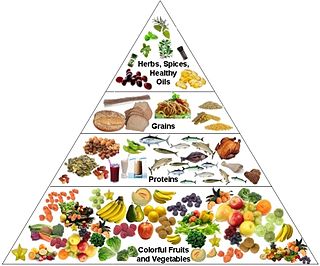Related Research Articles

In nutrition, biology, and chemistry, fat usually means any ester of fatty acids, or a mixture of such compounds, most commonly those that occur in living beings or in food.
Vitamin E is a group of eight fat soluble compounds that include four tocopherols and four tocotrienols. Vitamin E deficiency, which is rare and usually due to an underlying problem with digesting dietary fat rather than from a diet low in vitamin E, can cause nerve problems. Vitamin E is a fat-soluble antioxidant which may help protect cell membranes from reactive oxygen species. Worldwide, government organizations recommend adults consume in the range of 3 to 15 mg per day. As of 2016, consumption was below recommendations according to a worldwide summary of more than one hundred studies that reported a median dietary intake of 6.2 mg per day for alpha-tocopherol.
Tocopherols are a class of organic compounds comprising various methylated phenols), many of which have vitamin E activity. Because the vitamin activity was first identified in 1936 from a dietary fertility factor in rats, it was named tocopherol, from Greek τόκοςtókos 'birth' and φέρεινphérein 'to bear or carry', that is 'to carry a pregnancy', with the ending -ol signifying its status as a chemical alcohol.

Folate, also known as vitamin B9 and folacin, is one of the B vitamins. Manufactured folic acid, which is converted into folate by the body, is used as a dietary supplement and in food fortification as it is more stable during processing and storage. Folate is required for the body to make DNA and RNA and metabolise amino acids necessary for cell division. As humans cannot make folate, it is required in the diet, making it an essential nutrient. It occurs naturally in many foods. The recommended adult daily intake of folate in the U.S. is 400 micrograms from foods or dietary supplements.
Orthomolecular medicine is a form of alternative medicine that aims to maintain human health through nutritional supplementation. The concept builds on the idea of an optimal nutritional environment in the body and suggests that diseases reflect deficiencies in this environment. Treatment for disease, according to this view, involves attempts to correct "imbalances or deficiencies based on individual biochemistry" by use of substances such as vitamins, minerals, amino acids, trace elements and fatty acids. The notions behind orthomolecular medicine are not supported by sound medical evidence, and the therapy is not effective for chronic disease prevention; even the validity of calling the orthomolecular approach a form of medicine has been questioned since the 1970s.

The Mediterranean diet is a diet inspired by the eating habits and traditional food typical of Portugal, southern Spain, southern Italy, Crete and much of the rest of Greece discovered internationally in the early 1960s. This differentiates it from Mediterranean cuisine, which occurs naturally in Mediterranean countries and is inherent to them. While inspired by a specific time and place, the "Mediterranean diet" was later proven and refined based on the results of multiple scientific studies.

Cholecalciferol, also known as vitamin D3 and colecalciferol, is a type of vitamin D that is made by the skin when exposed to sunlight; it is found in some foods and can be taken as a dietary supplement.

A multivitamin is a preparation intended to serve as a dietary supplement with vitamins, dietary minerals, and other nutritional elements. Such preparations are available in the form of tablets, capsules, pastilles, powders, liquids, or injectable formulations. Other than injectable formulations, which are only available and administered under medical supervision, multivitamins are recognized by the Codex Alimentarius Commission as a category of food.

The Women's Health Initiative (WHI) was a series of clinical studies initiated by the U.S. National Institutes of Health (NIH) in 1991, to address major health issues causing morbidity and mortality in postmenopausal women. It consisted of three clinical trials (CT) and an observational study (OS). In particular, randomized controlled trials were designed and funded that addressed cardiovascular disease, cancer, and osteoporosis.
Megavitamin therapy is the use of large doses of vitamins, often many times greater than the recommended dietary allowance (RDA) in the attempt to prevent or treat diseases. Megavitamin therapy is typically used in alternative medicine by practitioners who call their approach orthomolecular medicine. Vitamins are useful in preventing and treating illnesses specifically associated with dietary vitamin shortfalls, but the conclusions of medical research are that the broad claims of disease treatment by advocates of megavitamin therapy are unsubstantiated by the available evidence. It is generally accepted that doses of any vitamin greatly in excess of nutritional requirements will result either in toxicity or in the excess simply being metabolised; thus evidence in favour of vitamin supplementation supports only doses in the normal range. Critics have described some aspects of orthomolecular medicine as food faddism or even quackery. Research on nutrient supplementation in general suggests that some nutritional supplements might be beneficial, and that others might be harmful; several specific nutritional therapies are associated with an increased likelihood of the condition they are meant to prevent.

Dietary factors are recognized as having a significant effect on the risk of cancers, with different dietary elements both increasing and reducing risk. Diet and obesity may be related to up to 30–35% of cancer deaths, while physical inactivity appears to be related to 7% risk of cancer occurrence.

The Western pattern diet is a modern dietary pattern that is generally characterized by high intakes of pre-packaged foods, refined grains, red meat, processed meat, high-sugar drinks, candy and sweets, fried foods, conventionally-raised animal products, butter and other high-fat dairy products, eggs, potatoes, corn, and low intakes of fruits, vegetables, whole grains, pasture-raised animal products, fish, nuts, and seeds.
The chronic endothelial injury hypothesis is one of two major mechanisms postulated to explain the underlying cause of atherosclerosis and coronary heart disease (CHD), the other being the lipid hypothesis. Although an ongoing debate involving connection between dietary lipids and CHD sometimes portrays the two hypotheses as being opposed, they are in no way mutually exclusive. Moreover, since the discovery of the role of LDL cholesterol (LDL-C) in the pathogenesis of atherosclerosis, the two hypotheses have become tightly linked by a number of molecular and cellular processes.

Vitamin D deficiency or hypovitaminosis D is a vitamin D level that is below normal. It most commonly occurs in people when they have inadequate exposure to sunlight, particularly sunlight with adequate ultraviolet B rays (UVB). Vitamin D deficiency can also be caused by inadequate nutritional intake of vitamin D; disorders that limit vitamin D absorption; and disorders that impair the conversion of vitamin D to active metabolites, including certain liver, kidney, and hereditary disorders. Deficiency impairs bone mineralization, leading to bone-softening diseases, such as rickets in children. It can also worsen osteomalacia and osteoporosis in adults, increasing the risk of bone fractures. Muscle weakness is also a common symptom of vitamin D deficiency, further increasing the risk of fall and bone fractures in adults. Vitamin D deficiency is associated with the development of schizophrenia.
Canadian health claims by Health Canada, the department of the Government of Canada responsible for national health, has allowed five scientifically verified disease risk reduction claims to be used on food labels and on food advertising. Other countries, including the United States and Great Britain, have approved similar health claims on food labels.

Vitamin D is a group of fat-soluble secosteroids responsible for increasing intestinal absorption of calcium, magnesium, and phosphate, and many other biological effects. In humans, the most important compounds in this group are vitamin D3 (cholecalciferol) and vitamin D2 (ergocalciferol).

Exposing skin to the ultraviolet radiation in sunlight has both positive and negative health effects. On the positive side, exposure allows for the synthesis of vitamin D3. Vitamin D has been suggested as having a wide range of positive health effects, which include strengthening bones and possibly inhibiting the growth of some cancers. A dietary supplement can also supply vitamin D, but there are also benefits to exposure not obtainable through Vitamin D supplementation. Long-term sun exposure is associated with reduced all-cause mortality and reduced mortality risk from cardiovascular disease (CVD), some forms of cancer, and non-CVD/noncancer related disease, with indications in these studies that Vitamin D is not the mediator. Supplementation offers limited bioavailability and no synthesis of subdermal nitric oxide. UV exposure also has positive effects for endorphin levels, and possibly for protection against multiple sclerosis. Abundant visible light to the eyes gives health benefits through its association with the timing of melatonin synthesis, maintenance of normal and robust circadian rhythms, and reduced risk of seasonal affective disorder.
The Bradford Hill criteria, otherwise known as Hill's criteria for causation, are a group of nine principles that can be useful in establishing epidemiologic evidence of a causal relationship between a presumed cause and an observed effect and have been widely used in public health research. They were established in 1965 by the English epidemiologist Sir Austin Bradford Hill.

Nutritional epidemiology examines dietary and nutritional factors in relation to disease occurrence at a population level. Nutritional epidemiology is a relatively new field of medical research that studies the relationship between nutrition and health. It is a young discipline in epidemiology that is continuing to grow in relevance to present-day health concerns. Diet and physical activity are difficult to measure accurately, which may partly explain why nutrition has received less attention than other risk factors for disease in epidemiology. Nutritional epidemiology uses knowledge from nutritional science to aid in the understanding of human nutrition and the explanation of basic underlying mechanisms. Nutritional science information is also used in the development of nutritional epidemiological studies and interventions including clinical, case-control and cohort studies. Nutritional epidemiological methods have been developed to study the relationship between diet and disease. Findings from these studies impact public health as they guide the development of dietary recommendations including those tailored specifically for the prevention of certain diseases, conditions and cancers. It is argued by western researchers that nutritional epidemiology should be a core component in the training of all health and social service professions because of its increasing relevance and past successes in improving the health of the public worldwide. However, it is also argued that nutritional epidemiological studies yield unreliable findings as they rely on the role of diet in health and disease, which is known as an exposure that is susceptible to considerable measurement error.

The Seven Countries Study is an epidemiological longitudinal study directed by Ancel Keys at what is today the University of Minnesota Laboratory of Physiological Hygiene & Exercise Science (LPHES). Begun in 1956 with a yearly grant of US$200,000 from the U.S. Public Health Service, the study was first published in 1978 and then followed up on its subjects every five years thereafter.
References
- 1 2 Carneiro, Ilona. (2011). Introduction to epidemiology. Howard, Natasha. (2nd ed.). Maidenhead, Berkshire: Open University Press. p. 76. ISBN 978-0-335-24462-1. OCLC 773348873.
- ↑ Motulsky, Harvey (2018). Intuitive biostatistics : a nonmathematical guide to statistical thinking (Fourth ed.). New York. p. 477. ISBN 978-0-19-064356-0. OCLC 1006531983.
- ↑ Bruce, Nigel, 1955- (29 November 2017). Quantitative methods for health research : a practical interactive guide to epidemiology and statistics. Pope, Daniel, 1969-, Stanistreet, Debbi, 1963- (Second ed.). Hoboken, NJ. p. 82. ISBN 978-1-118-66526-8. OCLC 992438133.
{{cite book}}: CS1 maint: multiple names: authors list (link) - ↑ Morgenstern, Hal (1995). "Ecologic Studies in Epidemiology: Concepts, Principles, and Methods". Annual Review of Public Health. 16 (1): 61–81. doi: 10.1146/annurev.pu.16.050195.000425 . ISSN 0163-7525. PMID 7639884.
- ↑ Newsom, 2006
- ↑ Kaufmann SH; Schaible UE (2005). "100th anniversary of Robert Koch's Nobel Prize for the discovery of the tubercle bacillus". Trends Microbiol. 13 (10): 469–75. doi:10.1016/j.tim.2005.08.003. PMID 16112578.
- ↑ Armstrong B; Doll R (1975). "Environmental factors and cancer incidence and mortality in different countries, with special reference to dietary practices". Int J Cancer. 15 (4): 617–31. doi:10.1002/ijc.2910150411. PMID 1140864. S2CID 2595273.
- ↑ Grant WB (2014). "A multicountry ecological study of cancer incidence rates in 2008 with respect to various risk-modifying factors". Nutrients. 6 (1): 163–189. doi: 10.3390/nu6010163 . PMC 3916854 . PMID 24379012.
- ↑ Tominaga S; Kuroishi T (1997). "An ecological study on diet/nutrition and cancer in Japan". Int J Cancer. 71 (Suppl 10): 2–6. doi: 10.1002/(sici)1097-0215(1997)10+<2::aid-ijc2>3.3.co;2-0 . PMID 9209011.
- ↑ Garland CF; Garland FC (1980). "Do sunlight and vitamin D reduce the likelihood of colon cancer?". Int J Epidemiol. 9 (3): 227–31. doi:10.1093/ije/9.3.227. PMID 7440046.
- ↑ Moukayed M; Grant WB (2013). "Molecular link between vitamin D and cancer prevention". Nutrients. 5 (10): 3993–4023. doi: 10.3390/nu5103993 . PMC 3820056 . PMID 24084056.
- ↑ Grant WB (1997). "Dietary Links to Alzheimer's Disease" (PDF). Alzheimer's Disease Review. 2: 42–57. Archived from the original (PDF) on 2014-06-05. Retrieved 2014-01-27.
- ↑ Devanand D; Lee J; Luchsinger J; Manly J; Marder K; Mayeux R; Scarmeas N; Schupf N; Stern Y (2013). "Lessons from epidemiologic research about risk factors, modifiers, and progression of late onset Alzheimer's Disease in New York City at Columbia University Medical Center". J Alzheimers Dis. 33 (Suppl 1): S447-55. doi:10.3233/JAD-2012-129041. PMC 4149254 . PMID 22836187.
- ↑ Grant WB (2014). "Trends in diet and Alzheimer's disease during the nutrition transition in Japan and developing countries". J Alzheimers Dis. 38 (3): 611–20. doi:10.3233/JAD-130719. PMID 24037034.
- ↑ Cannell JJ; Vieth R; Umhau JC; Holick MF; Grant WB; Madronich S; Garland CF; Giovannucci E (2006). "Epidemic influenza and vitamin D". Epidemiol Infect. 134 (6): 1129–40. doi:10.1017/S0950268806007175. PMC 2870528 . PMID 16959053.
- ↑ Urashima M; Segawa T; Okazaki M; Kurihara M; Wada Y; Ida H (2010). "Randomized trial of vitamin D supplementation to prevent seasonal influenza A in schoolchildren". Am J Clin Nutr. 91 (5): 1255–60. doi: 10.3945/ajcn.2009.29094 . PMID 20219962.